


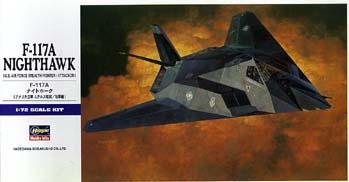 Hasegawa
1/72 F-117 Nighthawk
Hasegawa
1/72 F-117 Nighthawk
By Chris Bucholtz
History
Though few people realize it, the F-117 'Stealth Fighter' had its origins in the 1972 Arab-Israeli war, where a disturbingly high number of U.S.-built aircraft fell victim to new-generation Soviet anti-air defense systems. Building from a strong theoretical basis and several fortuitous accidental discoveries, Northrop and Lockheed each submitted proposals to the U.S. Air Force. The technology employed a faceted surface that reflected radar energy away from its source, thus dramatically reducing the plane's radar signature. The final plane used a 'platypus'-style exhaust area to reduce the infrared signature of the plane by mixing exhaust gasses with cold air, and a passive sensor system rather than an active radar to minimize radiation from the plane.
The Lockheed proposal evolved first into the'Have Blue' developmental aircraft and later the F-117, the epitome of the black project, right down to the surface finish (chosen by the Air Force over more effective gray schemes for 'psychological purposes,' according to one project officer). Test pilots were brought in from the F-4, F-111 and A-10 communities and were not told what they were working on until they were face to face with the plane. Support equipment had to be found from off-the-shelf sources so as to not draw attention to the project, and to this day, the plane's boarding ladder is a common triple-fold ladder available at any hardware store.
The first aircraft flew in June 1981, and the plane became operational in October 1983. For years, the plane remained a secret before being unveiled to the public. It received its baptism of fire in the 1989 invasion of Panama, but faulty intelligence gave the two F-117 pilots the wrong coordinates and they missed the assigned target. Two years later, however, the Nighthawk redeemed itself in spades by flying deep into Iraqi territory and striking heavily-defended high-value targets without suffering a loss.
The Kit
There have been many models of the F-117 in 1:72 scale, but none of them have been truly accurate. All of them suffered from some flaw – a messed-up exhaust section, wings that swept too little, or facets that were completely missed. The Hasegawa kit seems to have avoided these pitfalls, and as a result is the most accurate 1:72 kit of them all, with such nice touches as a detailed forward and downward infrared units, well done landing gear, and a mix of raised and recessed panel lines. There are also a few maddening engineering flaws that Hasegawa could have avoided.
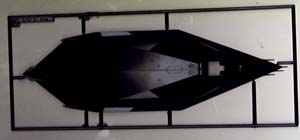 |
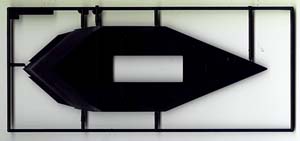 |
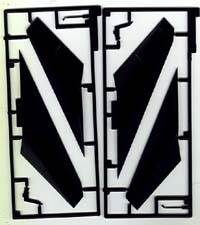 |
 |
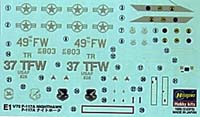 |
The cockpit has more parts than the usual Hasegawa cockpit, but is just as devoid of detail as most of their recent kits. The ACES II seat is a three-piece affair and appears slightly oversized; two canopy actuating rods allow the modeler to pose the canopy in the raised position, but their mounting points – the sides of the seat – are extremely dubious. The control column is nice enough, but the cockpit tub's sidewalls are devoid of decals and the control panel has only the three multi-function display screens. Decals provide some rudimentary instrumentation. A heads-up display unit goes on top of the control panel, but this part suffers from sink marks on both sides.
The cockpit tub fits into the bottom of the upper fuselage half. A plastic 'weight' is provided to go in the nose to keep the model on its nose wheel. There is no bomb bay provided, although the belly has the cutout, requiring the modeler to add the door carefully. This feature leads your reviewer to expect a second, 'deluxe' version of the kit to surface soon.
When the cockpit, bomb bay door and nose weight are in place, you can add the lower fuselage to the upper fuselage. Unlike other kits, the lower half fits into a recessed opening in the top half, assuring positive alignment. The platypus exhausts are provided for, but there are sink marks on the bottom of the fuselage opposite the vertical vanes that will need to be cleaned up. Don't worry about the ejection pin marks that line the lower fuselage aft of these vanes; the upper fuselage has a flange that will cover and hide these marks.
The wings and tail go on next, with little effort. The intakes are blanked off, and the screens are represented by a plastic plate with an grid pattern etched on it. These are well shaped but look a little on the cheesy side. The good news is that, when the screens are added, the basic airframe is finished.
The landing gear bays are provided on the lower fuselage, and here's where the kit becomes frustrating. While the nose gear strut is lovely, the wheels each have two ejection pin marks right on the round edge of the tire. Every gear door also features an ejector pin mark or two on their inner surfaces, endangering the structural detail Hasegawa provides. Particularly onerous is the nose wheel door, which has its marks inside depressions in the detail, making it impossible to get at without a Dremel tool and a dental bit. The opposite sides of these doors are flat; your reviewer wishes that Hasegawa would put these flaws in the easiest location to clean up – the outside – instead of right in the middle of intricate detail.
Once the gear, gear doors and wheels are in place, itís time for the clear parts. These are very well done, and include a HUD reflector and covers for the forward and downward-looking infrared turrets.
The decals allow you to build two planes: the 49th Fighter Wing's Commander's aircraft and a plane from the 37th Tactical Fighter Wing. Although no dates are given for these planes, narrowing them down is easy; the first plane is for Brig. Gen. Bruce Carlson, who was the CO of the 49th FW from Feb. 10, 1995 to August 23 1996. The other aircraft has the name of Col. Tony Tolin on the canopy rail; he served as 37th commander from TFW Oct. 5, 1989 to Aug. 16, 1990, two days before the deployment of 20 F-117s to Saudi Arabia. The choice of these two non-combat schemes again indicates that a second kit with a bomb bay (and, thus, the colorful Desert Storm bay door art) may be on its way.
Conclusion
If it weren't for the ejector pin marks on the undercarriage parts, this would be a very quick build indeed. Even so, it's the most accurate Stealth fighter available in 1:72 and, modern jet builders will appreciate the small things Hasegawa includes in its moldings.
Our thanks to HobbyLink Japan for this review sample!

Previous: Contents








